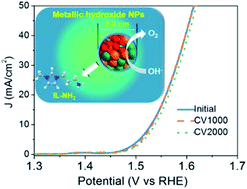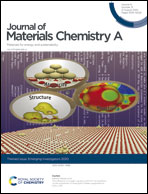Ionic liquid-assisted one-step preparation of ultrafine amorphous metallic hydroxide nanoparticles for the highly efficient oxygen evolution reaction†
Abstract
Amorphous metal hydroxides (AMHs) of earth-abundant transition metal elements (Fe, Co and Ni) have emerged as promising electrocatalysts for developing clean energy and conversion, especially toward the anode oxygen evolution reaction (OER), owing to their low cost, high conductivity and amorphous structures. Here, as a proof-of-concept experiment, a rapid one-step and very effective synthesis strategy is reported for the first time to produce a family of ionic liquid-modified AMH nanoparticles as highly efficient OER electrocatalysts. The ionic liquid-modified bimetallic FeNi hydroxide nanoparticles exhibit remarkable OER activity with a Tafel slope of 54.4 mV dec−1 and an overpotential of 300 mV for 10 mA cm−2 (loading: ∼0.009 mgFeNi cm−2). Further, the universal applicability of this strategy for designing the AMH nanoparticles extends to other metallic hydroxide nanoparticles (Fe, Co, Ni, FeCo and NiCo). This work may provide a novel synthetic protocol to design amorphous metal hydroxide nanoparticle catalysts for the efficient OER.

- This article is part of the themed collection: Journal of Materials Chemistry A Emerging Investigators


 Please wait while we load your content...
Please wait while we load your content...